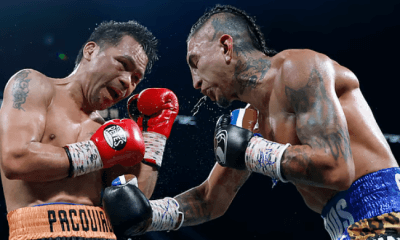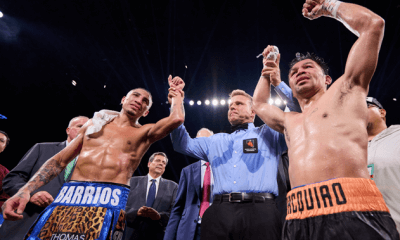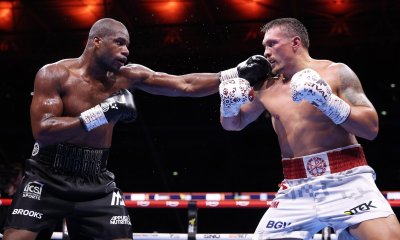Articles
‘The Striking Truth’: Georges St-Pierre Documentary Review from the Canadian Premiere
 GSP, Loiseau and director Wong. This film was hindered by the UFC's decision not to allow Wong to use fight footage.
GSP, Loiseau and director Wong. This film was hindered by the UFC's decision not to allow Wong to use fight footage.
TORONTO – This is the “story of pain,” says MMA fighter David Loiseau in the new documentary ‘The Striking Truth’, and it was – for the audience.
The story of UFC welterweight champion Georges St-Pierre (GSP) and David Loiseau unfolds much like that of David Lynch’s ‘Mulholland Drive’; disjointed and abstruse. As a director known for his surrealist works, Lynch can avert scrutiny for leaving the moviegoers in perpetual perturbation, but for Steven Wong the lack of focus is less amicable. It becomes obvious in the middle of the film, when Loiseau states that the original intent was to portray the rise of two Montreal-based MMA fighters, that the objective is compromised when Loiseau began to struggle to hold his position as UFC fighter. Just as ‘Mulholland Drive’ was initially filmed as a television pilot and only after being rejected was completed as a feature film, the aim of ‘The Striking Truth’ apostatizes in its development and attempts to reconstruct a partially finished product, only to fail miserably.
‘The Striking Truth’ starts on a light note, with GSP taking the viewer on a guided tour of his home as it was in 2006 while the credits are rolling. After the opening sequence, the film takes on a serious tone with training scenes accompanied by intense and somber background music. This builds up the audience inefficaciously, with the intended rises and falls insubstantially cemented by narrated chapters that break up the film’s loosely defined parts. Moreover, for lack of authorization by the UFC to use fight footage, the greatest and worst moments of these fighters’ lives are simplified into single white sentences briefly displayed on black screens that surround the narratives. This monotonous tone devalues the climax of the film – Loiseau’s regrettable decision to retire from his lifelong dream, and the only scene with potential to somewhat redeem the rest of the movie – having limited affect on the audience.
The stories comprising ‘The Striking Truth’ are cohesive and compelling in themselves, bringing to light the humble beginnings of GSP’s life on a farm and Loiseau’s Haitian heritage, yet the film in its entirety fails to bring them together with clear and meaningful direction. Wong’s use of blatant and uninspired symbolism is an attempt to connect them in a way that you would normally expect from low budget student films. This is shown in a few scenes, including GSP playing chess with the black king piece falling dramatically, and GSP and Loiseau running together and then separating at a fork in the road. Not only do these scenes not contribute any significant value to the film, but several of these obvious fillers are repeated much to the embarrassment of the film’s high budget. The only truly amusing symbolism portrayed is seen in the foreshadowing of Loiseau’s fate through his abundance of “Tap Out” attire, though it is tragic coincidence rather than clever placement that causes the connection.
There are a few key factors that made the film particularly disappointing, especially for the overflow of die hard fans to the sport, that having been different would have provided Wong considerably better material to work with. The most substantial of these was the absence of UFC footage, which would have removed the need for the fluff that made up so much of the film and more importantly would have given the fans a notable connection to the characters. On top of this, the movie was intended to be in 3D and relying on this the shots were consequently rendered borderline artistic at best.
With three hundred hours of filming cut down to about two, you would expect a lot more from the final cuts. However, Wong’s inexperience, having only worked on commercials and infomercials previously, serves as a deficient foundation for the influential documentary the two fighters deserve.
The film’s flop does not completely rest on Wong’s shoulders – being given a large budget on little experience is a predicament from which few could prevail. Furthermore, the film rested on a naturally perilous plot that ended up being the rough conclusion to the film; the fragility of the UFC is such that anything can happen – and it did. Following this, Wong attempted to string moments differing greatly in intention into one fluid plot, like a mishmash of puzzle pieces from varying sets that could only ever combine at best into a void-filled cacophonous mosaic.
—Erica Read is a Canadian writer based in Toronto
-

 Featured Articles3 weeks ago
Featured Articles3 weeks agoThe Hauser Report: Zayas-Garcia, Pacquiao, Usyk, and the NYSAC
-

 Featured Articles2 weeks ago
Featured Articles2 weeks agoOscar Duarte and Regis Prograis Prevail on an Action-Packed Fight Card in Chicago
-

 Featured Articles2 weeks ago
Featured Articles2 weeks agoThe Hauser Report: Cinematic and Literary Notes
-

 Book Review7 days ago
Book Review7 days agoMark Kriegel’s New Book About Mike Tyson is a Must-Read
-

 Featured Articles4 weeks ago
Featured Articles4 weeks agoManny Pacquiao and Mario Barrios Fight to a Draw; Fundora stops Tim Tszyu
-

 Featured Articles4 weeks ago
Featured Articles4 weeks agoArne’s Almanac: Pacquiao-Barrios Redux
-

 Featured Articles3 weeks ago
Featured Articles3 weeks agoRemembering Dwight Muhammad Qawi (1953-2025) and his Triumphant Return to Prison
-

 Featured Articles4 weeks ago
Featured Articles4 weeks agoOleksandr Usyk Continues to Amaze; KOs Daniel Dubois in 5 One-Sided Rounds















